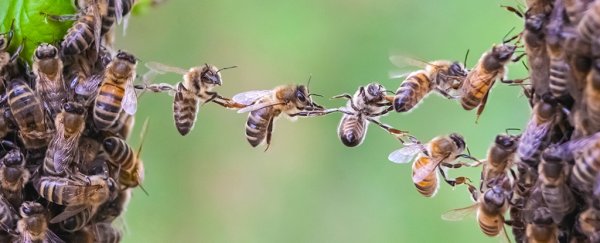On their own, bee brains are fairly remarkable things, although human computing power still trumps them. But new research suggests that individual members of a swarm behave surprisingly like neurons in a human brain.
Not only does this tell us something about how these remarkable creatures interact - studying 'bee speak' could tell us a thing or two about how our own minds make decisions.
A team of researchers from the University of Sheffield in the UK applied a theoretical model commonly used to study human psychology to the behaviour of bee colonies.
It's not unusual for scientists to see if animals follow the kinds of psychological laws that govern our own brains.
For example, in the field of psychophysics a rule called Weber's law describes a relationship between the size of a stimulus and noticeable increases in its magnitude.
It works like this: imagine lifting an apple, compared to lifting three apples - you'd notice a difference. But if somebody secretly slipped a few apples into your overloaded shopping bag, it's unlikely you'd spot the difference.
This general rule about stimulus and perception has been observed in all manner of animals, from other mammals to birds to fish.
While the law also seems to fit the collective behaviour of simpler organisms – it's been observed in brainless amoeba such as slime mould – it hadn't yet been studied in whole clusters of tiny brains such as an insect hive.
To investigate its role in the decision making processes of the European honey bee (Apis mellifera), the researchers watched hives split apart and hunt for new homes.
Specifically, they analysed how quickly the colonies made decisions between sites of varying qualities and plugged the data into several psychophysics laws to see how well they fit.
In addition to Weber's law, the researchers analysed Pieron's law; a rule that says we make decisions faster when two choices are high quality, and a rule called Hick's law that says brains take more time to choose as the number of options goes up.
Decision making in human brains involves the actions of single nerves firing waves of electrochemical signals.
Among bees, the process of choosing a hive comes down to the interactions of scout bees communicating their discoveries through a visual display of body wiggles.
Going by the results of the study, the competition between bee-wiggles and nerve-firing both follow the same general laws behind decision making.
"The study also supports the view of bee colonies as being similar to complete organisms," says computer scientist and lead author Andreagiovanni Reina.
"Or better still, superorganisms, composed of a large number of fully developed and autonomous individuals that interact with each other to bring forth a collective response."
Identifying the connections between such vastly different systems as brains and bee hives can help us make sense of how simple actions emerge from complex systems.
This study is a good start, but the researchers note it's still only a computational model based on a handful of observations.
If it is supported by even more data, future work could zero in on the unique ways each system achieves these results, telling us more about how psychology arises from little more than waves of chemicals in nerve cells.
If nothing else, watching bees look for a new home is a lot easier than trying to watch neurons blink.
"Finding similarities between the behaviour of honeybee colonies and brain neurons is useful because the behaviour of bees selecting a nest is simpler than studying neurons in a brain that makes decisions," says Reina.
This research was published in Scientific Reports.
